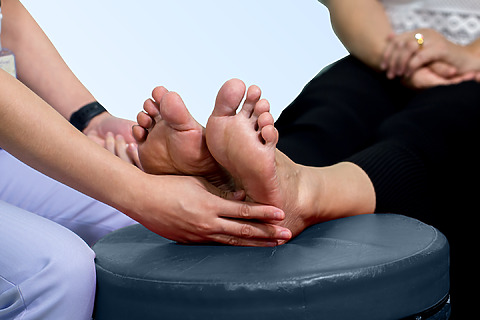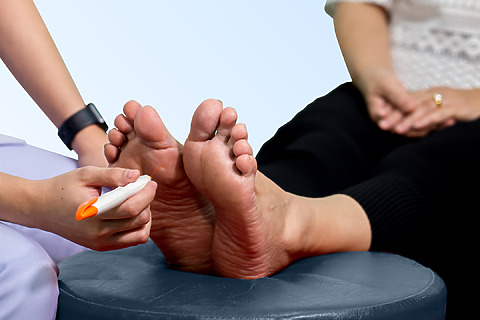Biomag - Encyclopedia - Diabetic foot
Diabetic Foot - symptoms, description and treatment

Author MUDr. Peter Bednarčík CSc.
Revision
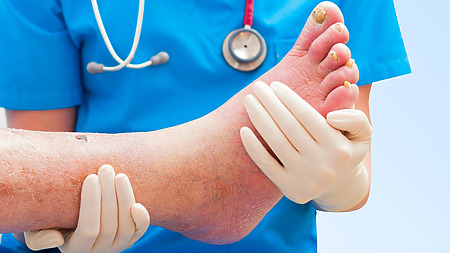
What does a diabetic foot look like? You get cracks, blisters and various painful wounds on your feet. It is one of the problems that mainly affect patients with diabetes, neuropathy or non-diabetic lower limbs. It can be a source of pain and other health complications.
Find out what are the symptoms and causes of this disease, what treatment options exist for diabetic foot. How to suppress symptoms such as pain, inflammation and impaired blood flow that accompany this disease? Read more here.
Symptoms of diabetic foot
The main symptoms are:
- Changes in the perception of temperature, foot pressure.
- Changes in the perception of pain in the feet.
- Excessive cornification of the skin (hyperkeratosis).
- Formation of blisters.
- Formation of ulcers (ulceration) on the toes, soles and heels [1].
If an infection is added, patients may have fever, chills and fluctuating blood sugar levels. [2]. The exact form of diabetic foot symptoms can vary depending on whether the cause is nerve damage or impaired blood flow to the extremities.
- Problems of neurological origin are most often manifested by ulcers on the ball of the toe or on the heel, i.e. at the point of greatest pressure on the foot. The wounds are usually not painful and the foot is warm and pink.
- In contrast, problems with blood circulation in the feet lead to ulcers on the toes, between the toes or on the heel. The wounds are painful and the foot is cold and bruised. [3]

Only a doctor can make a correct diagnosis. Do not use this or any other article on the internet to make a diagnosis. Do not delay seeing a doctor and address your condition early.
Description and causes of diabetic foot
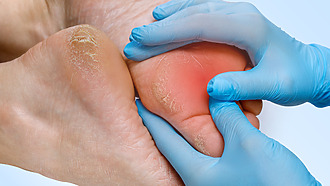
What is diabetic foot?
Diabetic foot (also known as diabetic foot syndrome) involves tissue disruption, ulceration and often infection in wounds that form on the foot from the ankle downwards.
These problems are most common in patients with diabetes and in people who have poor circulation in their legs (lower limb ischaemia). It is a serious complication of diabetes and occurs in up to 6% of newly diagnosed diabetics each year.[4]
Diabetic foot causes
The main reasons why diabetics develop different types of wounds on their feet include circulation problems and nerve damage. These health complications are especially common in diabetics who do not have stable blood sugar levels or do not adhere to prescribed treatment. [5]
ITcan also cause reduced joint mobility, which affects approximately half of diabetics. [6]
Diabetic foot risk factors
- Poorly controlled diabetes (blood sugar levels are not at the right level in the long term),
- being overweight,
- high blood pressure,
- elevated cholesterol levels
- reduced pain perception, where it is easy to miss incipient problems,
- inadequate foot care. [7]
Stages of diabetic foot syndrome
The stages show the severity of wounds and damage to the foot. For example, the Wagner classification is used.
Stage 1 – the patient has diabetic ulcers only on the surface of the skin (superficial ulceration).
Stage 2 – deeper ulcers appear but are without serious infection.
Stage 3 – deep ulcers extend to the bone or joint, or the ulcers are not as deep but have severe infection.
Stage 4 – gangrene (tissue death) appears on the toes, heel and other areas of the feet.
Stage 5 – gangrene affects the whole leg [8].
Diagnosis of diabetic foot
- When making a diagnosis, it is important to tell the doctor all the information about diabetes, associated complications and the first signs of skin damage on the feet. You should also mention whether you smoke and if you have any difficulty walking.
- The specialist performs a careful check of the condition of the feet – they listen to the arteries with a phonendoscope, checks the pulse by palpation and watches for swelling, blisters or bone deformities (for example, hammer toes). He will also check footwear, as inappropriate shoes are often the reason why foot wounds occur.
- Patients undergo a neurological and vascular examination of the lower limbs and a wound swab to detect the presence of infection. An X-ray of the foot is performed as needed and the diabetic status is checked with blood tests.[9]
Did you know?
- Diabetic foot heals in only two-thirds of patients.
- Almost 30% of cases end in amputation of varying degrees.
- Four out of five cases of diabetic foot are caused by external problems, such as improper footwear. [10]
Complications when left untreated
It is a serious disease that can have many complications if not treated properly.
- Infections: The diabetic foot is prone to infections.
- Gangrene: Gangrene is a serious form of infection. It causes tissue death. It can lead to amputation of the affected part of the limb.
- Ulcers: It can cause ulcers on the foot. These can become infected and worsen.
- Circulatory disorders: Can lead to swelling, pain and skin discolouration.
Infection
Gangrene
Ulcers
Necrosis

We recommend not postponing treatment of diabetic foot
Do not delay treatment for diabetic foot, and see a specialist if you have any health problems or doubts about your condition. This will prevent unnecessary health complications.
Diabetic toot: treatment
Treatment of diabetic foot depends on the severity of the problems and their exact origin. Diabetics often ask if it is treatable. Two-thirds of patients are cured, but up to 40% of patients will have their diabetic foot problems return within the next year. [11]
Therapy of diabetic foot syndrome is either through various regimens and supportive measures or through surgery. The aim of the treatment is to keep the leg in such a state that it is functional and the patient does not have to undergo amputation.[12]
Non-invasive procedure

- Foot relief using special footwear or various aids (e.g. plaster casts, crutches and canes),
- consistent wound care, especially if infected,
- treatment of any infection with antibiotics,
- improving blood sugar levels, regular and careful checking of all parts of the feet. [13]
Wound care for diabetic foot includes:
- Systematic cleaning of ulcers, treatment of infection, control of wound secretions and promotion of healing.
- Protection against the development of further wounds is a must.
- The use of modern covering materials for so-called moist healing, which can create good conditions for wound healing. [14]
Care for the diabetic foot
Foot care for people with diabetes is an integral part of life. Not only do healthy feet need regular care, diabetic foot care is much more essential.
- Check the condition of your feet every day. Pay attention to any skin changes, cracks, wounds or blisters.
- Adhere to daily foot hygiene.
- Carefully trim your toenails and don’t underestimate professional pedicures.
- Wear comfortable shoes of the right size, and socks.
- Protect your feet from extreme temperatures – hot and cold. [15]
Lubricating foot can have positive effects such as hydration, protection, healing and comfort. The choice of ointment depends on individual needs. Generally moisturising ointments, ointments containing antiseptics, antibiotics or corticosteroids are used.
Surgical treatment
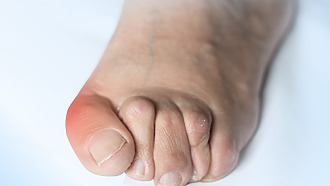
It means, for example, an operation to improve and restore blood flow in the arteries (technically called revascularisation). Commonly, operations are performed to remove dead or infected tissue, clean out ulcers and create the right conditions for wound healing. In some cases, foot deformities (such as hammertoes) that increase the risk of developing diabetic foot can be surgically removed. [16]

Beware
Treatment of diabetic foot can only be determined by your physician after considering your overall health. Therefore, do not use this article as a guide to treatment, which can only be determined by a physician.
Prevention of diabetic foot
Prevention is important to maintain a functional limb and can significantly reduce the number of amputations. What exactly should you do to prevent the development of diabetic foot?
- Follow your diabetes treatment and check your blood sugar regularly.
- Have your feet checked regularly by a doctor.
- Learn to recognize the signs of early stage diabetic foot.
- Don’t underestimate the importance of choosing flexible, wide-enough shoes without hard seams.
- Use your feet, not your shoulders, when lifting heavy objects.
- Examine your feet and the area between your toes every day. Remove hard, dry skin gently and lubricate your feet.
- Do not go barefoot and wear cotton socks.
- Do not smoke.
- See a doctor as soon as possible for any new wound, pain, swelling or unusual changes in the skin on your feet. [17]
Glossary of terms for diabetic foot syndrome
As a patient, you may encounter a number of professional terms at the doctor. A glossary of common medical terms will help you understand what your doctor is saying.
- Diabetic neuropathy – nerve involvement in diabetes that manifests as reduced sensitivity in the feet. It is a risk factor for minor leg injuries [18]
- Diabetic microangiopathy – damage to small blood vessels that impairs blood flow in the affected part of the body, such as the legs. It is caused by diabetes. [19]
- Glycaemia – the level of glucose (sugar) in the blood. [20]
- Ulceration – the formation of ulcers. [21]
- Debridement – surgical cleaning of a wound in which necrotic (dead) tissue is removed. [22]
- Granulation – the phase of wound healing in which new blood vessels and tissue are formed to allow the wound to heal [23]
- Podiatry – the specialty concerned with the diagnosis and treatment of foot diseases. It involves doctors, physiotherapists, nurses, chiropodists and specialist shoemakers. [24]

Important cautions when dealing with diabetic foot
It is a common complication of diabetes.
The risk of isue is reduced by proper treatment of diabetes and overall foot care.
Every wound on the foot requires consistent care. [25]
Summary and recommendations for diabetic foot
See a physician
The treatment is always determined by a doctor based on a general examination, an assessment of your condition and an accurate diagnosis.
Causal treatment of diabetic foot
After a general examination, your doctor will recommend treatment for the cause of diabetic foot. In connection with this, they will also recommend possible lifestyle modification and further treatment.
Reducing pain, inflammation and improving blood circulation
Symptomatic treatment focuses on the manifestations or signs (symptoms) of the disease. Such treatment can significantly improve your quality of life and support comprehensive treatment during the course of the disease.
Sources, references and literature
[1] Jirkovská A., Lacigová S., Rušavý Z., Bém R. Recommended procedure for prevention, diagnosis and therapy of diabetic foot syndrome. Czech Diabetological Society of the Czech Academy of Sciences, 10. October 2016. https://www.diab.cz/dokumenty/standard_diab_noha.pdf
[2] Fletcher J. How can diabetes affect the feet? Medical News Today, 25. February 2022. https://www.medicalnewstoday.com/articles/317504
[3] Pitihova P. Diabetic foot syndrome – diagnostic and treatment options. Practical. pharmacies. 2010; 6(3): 130-133. https://www.praktickelekarenstvi.cz/pdfs/lek/2010/03/06.pdf
[4] Jirkovská A., Lacigová S., Rušavý Z., Bém R. Recommended procedure for prevention, diagnosis and therapy of diabetic foot syndrome. Czech Diabetological Society of the Czech Academy of Sciences, 10. October 2016. https://www.diab.cz/dokumenty/standard_diab_noha.pdf
[5] Fletcher J. How can diabetes affect the feet? Medical News Today, 25. February 2022. https://www.medicalnewstoday.com/articles/317504
[6] Jirkovská A., Lacigová S., Rušavý Z., Bém R. Recommended procedure for prevention, diagnosis and therapy of diabetic foot syndrome. Czech Diabetological Society of the Czech Academy of Sciences, 10. October 2016. https://www.diab.cz/dokumenty/standard_diab_noha.pdf
[7] Diabetes and your feet. Centers for Disease Control and Prevention, 20. June 2022. https://www.cdc.gov/diabetes/library/features/healthy-feet.html
[8] Jirkovská A., Lacigová S., Rušavý Z., Bém R. Recommended procedure for prevention, diagnosis and therapy of diabetic foot syndrome. Czech Diabetological Society of the Czech Academy of Sciences, 10. October 2016. https://www.diab.cz/dokumenty/standard_diab_noha.pdf
[9] Jirkovská A., Lacigová S., Rušavý Z., Bém R. Recommended procedure for prevention, diagnosis and therapy of diabetic foot syndrome. Czech Diabetological Society of the Czech Academy of Sciences, 10. October 2016. https://www.diab.cz/dokumenty/standard_diab_noha.pdf
[10] Jirkovská A., Lacigová S., Rušavý Z., Bém R. Recommended procedure for prevention, diagnosis and therapy of diabetic foot syndrome. Czech Diabetological Society of the Czech Academy of Sciences, 10. October 2016. https://www.diab.cz/dokumenty/standard_diab_noha.pdf
[11] Jirkovská A., Lacigová S., Rušavý Z., Bém R. Recommended procedure for prevention, diagnosis and therapy of diabetic foot syndrome. Czech Diabetological Society of the Czech Academy of Sciences, 10. October 2016. https://www.diab.cz/dokumenty/standard_diab_noha.pdf
[12] Fletcher J. How can diabetes affect the feet? Medical News Today, 25. February 2022. https://www.medicalnewstoday.com/articles/317504
[13] Jirkovská A., Lacigová S., Rušavý Z., Bém R. Recommended procedure for prevention, diagnosis and therapy of diabetic foot syndrome. Czech Diabetological Society of the Czech Academy of Sciences, 10. October 2016. https://www.diab.cz/dokumenty/standard_diab_noha.pdf; Fletcher J. How can diabetes affect the feet? Medical News Today, 25. February 2022. https://www.medicalnewstoday.com/articles/317504
[14] Jirkovská A., Lacigová S., Rušavý Z., Bém R. Recommended procedure for prevention, diagnosis and therapy of diabetic foot syndrome. Czech Diabetological Society of the Czech Academy of Sciences, 10. October 2016. https://www.diab.cz/dokumenty/standard_diab_noha.pdf
[15] Diabetic Foot. Medline Plus, https://medlineplus.gov/diabeticfoot.html#
[16] Jirkovská A., Lacigová S., Rušavý Z., Bém R. Recommended procedure for prevention, diagnosis and therapy of diabetic foot syndrome. Czech Diabetological Society of the Czech Academy of Sciences, 10. October 2016. https://www.diab.cz/dokumenty/standard_diab_noha.pdf
[17] Fletcher J. How can diabetes affect the feet? Medical News Today, 25. February 2022. https://www.medicalnewstoday.com/articles/317504; Jirkovská A., Lacigová S., Rušavý Z., Bém R. Recommended procedure for prevention, diagnosis and therapy of diabetic foot syndrome. Czech Diabetological Society of the Czech Academy of Sciences, 10. October 2016. https://www.diab.cz/dokumenty/standard_diab_noha.pdf
[18] The Great Medical Dictionary, Maxdorf, s.r.o. https://lekarske. slovniky.cz/pojem/diabeticka-neuropatie
[19] The Great Medical Dictionary, Maxdorf, s.r.o. https://lekarske. slovniky.cz/pojem/mikroangiopatie
[20] The Great Medical Dictionary, Maxdorf, s.r.o. https://lekarske. slovniky.cz/pojem/glykemie
[21] The Great Medical Dictionary, Maxdorf, s.r.o https://lekarske.slovniky.cz/pojem/ulcerace
[22] The Great Medical Dictionary, Maxdorf, s.r.o https://lekarske.slovniky.cz/pojem/debridement
[23] Pit’hová P. Diabetic foot syndrome – diagnostic and treatment options. Practical. pharmacies. 2010; 6(3): 130-133. https://www.praktickelekarenstvi.cz/pdfs/lek/2010/03/06.pdf
[24] Naughton B. Getting to Know Granulation Tissue and What it Means for Wound Care. Wound Source, 11.2.2021. https://www.woundsource.com/blog/getting-know-granulation-tissue-and-what-it-means-wound-care
[25] Czech Paediatric Society, z.s. Www.podiatrie.cz.
| Rate this article |
|
|
5/51 Reviewed by
|
How to control pain, inflammation and improve blood circulation?
The solution may be symptomatic treatment using pulsed magnetic therapy (PEMF therapy), which targets symptoms and signs such as pain, inflammation and impaired blood flow . In addition, such treatment can support comprehensive treatment and significantly improve quality of life.
Explaining the Effects
The basic principle of Biomag 3D pulsed magnetic therapy (PEMF therapy) is the generation of electromagnetic pulses. These pulses penetrate through clothing and through the entire depth of the tissue to the point of targeted application. The pulses have specially developed biotropic parameters (e.g. frequency, shape, intensity) to best affect various health problems
What are the effects of 3D magnetic therapy (PEMF therapy)?
- Helps relieve pain.
- Mitigates inflammation.
- Promotes blood circulation.
How is the treatment applied?
The application is very simple. You select the desired therapeutic effect on the device and attach the supplied applicator to the desired application site. Magnetic therapy is usually applied 2 times a day for 20 minutes.
We will be happy to help you try this method and advise you on which device to purchase.
